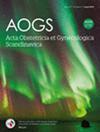Comparison of balloon catheter, oral misoprostol, or combination of both for cervical ripening in late-term and post-term nulliparous women: A Finnish randomized controlled multicenter pilot trial
Abstract
Introduction
Nulliparous women beyond term have high rates of induction failure. The aim of this study was to compare delivery outcomes for balloon catheter, misoprostol, and combination of both in nulliparous late- and post-term women with unfavorable cervices. We intended to explore whether the combination strategy has lower cesarean section rate and is as safe as either method alone.
Material and Methods
The randomized multicenter pilot trial was carried out in the five university hospitals and the largest secondary care hospital of Finland March 1, 2018–March 31, 2022. A total of 273 nulliparous women with viable singleton fetus in cephalic presentation, intact amniotic membranes, and an unfavorable cervix at 41 + 0 gestational weeks were included. The study protocol was registered in the ISCTN registry (ISRCTN83219789). The women were randomized into cervical ripening by balloon catheter, oral misoprostol 50 μg every 4 h, or the combination use of both. The primary outcomes of the study were the rates of cesarean section and composite of adverse neonatal outcomes (5-min Apgar score <7, umbilical artery pH ≤7.05, or NICU admission).
Results
Ninety-seven women (35.5%) were allocated in the balloon catheter arm, 94 (34.4%) in the oral misoprostol arm, and 82 (30.0%) in the combination treatment arm. The rates of cesarean section (balloon catheter 23.7%, n = 23/97, vs. oral misoprostol 24.5%, n = 23/94, vs. combination 17.1%, n = 14/82) or composite adverse neonatal outcome (7.2% vs. 7.4% vs. 7.3%, respectively) were not statistically significantly different between the groups. The median (interquartile range) induction to delivery interval was the shortest in the combination treatment, 21.7 (15.1–33.2) h compared to balloon catheter 31.7 (21.9–44.5) h; p < 0.01 or oral misoprostol 37.0 (26.7–60.3) h; p < 0.01. The proportion of women with induction to delivery interval ≤24 h was significantly higher in the combination arm compared to balloon catheter (54.4% vs. 31.1%; p < 0.01) or oral misoprostol (54.4% vs. 21.1%; p < 0.001).
Conclusions
Our findings confirm the effectiveness of combining balloon catheter and oral misoprostol for cervical ripening, showing shorter induction to delivery interval and comparable rates of cesarean section and neonatal outcomes compared to either method alone. These results advocate for a shift toward adopting combination strategy in the induction of nulliparous late- and post-term women.


 求助内容:
求助内容: 应助结果提醒方式:
应助结果提醒方式:


